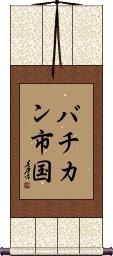Many custom options...
And formats...

Vatican City in Chinese / Japanese...
Buy a Vatican City calligraphy wall scroll here!
Personalize your custom “Vatican City” project by clicking the button next to your favorite “Vatican City” title below...
Vatican City
Vatican City
Vatican
Not the results for vatican city that you were looking for?
Below are some entries from our dictionary that may match your vatican city search...
| Characters If shown, 2nd row is Simp. Chinese |
Pronunciation Romanization |
Simple Dictionary Definition |
梵蒂岡城 梵蒂冈城 see styles |
fàn dì gāng chéng fan4 di4 gang1 cheng2 fan ti kang ch`eng fan ti kang cheng |
More info & calligraphy: Vatican City |
バチカン市国 see styles |
bachikanshikoku バチカンしこく |
More info & calligraphy: Vatican City |
市国 see styles |
shikoku しこく |
(See 都市国家) city-state (e.g. the Vatican) |
教皇領 see styles |
kyoukouryou / kyokoryo きょうこうりょう |
(See バチカン市国) (former) Papal States; Vatican City |
宗教都市 see styles |
shuukyoutoshi / shukyotoshi しゅうきょうとし |
(1) holy city; (2) city developed around a church, temple, shrine, etc. (e.g. Ise, Mecca, Vatican) |
聖伯多祿大殿 圣伯多禄大殿 see styles |
shèng bó duō lù dà diàn sheng4 bo2 duo1 lu4 da4 dian4 sheng po to lu ta tien |
St Peter's Basilica, Vatican City |
ヴァチカン市国 see styles |
achikanshikoku ヴァチカンしこく |
Vatican City State |
Variations: |
bachikanshikoku(bachikan市国); achikanshikoku(achikan市国) バチカンしこく(バチカン市国); ヴァチカンしこく(ヴァチカン市国) |
Vatican City; Vatican City State |
The following table may be helpful for those studying Chinese or Japanese...
| Title | Characters | Romaji (Romanized Japanese) | Various forms of Romanized Chinese | |
| Vatican City | バチカン市國 バチカン市国 | bachikan shikoku bachikanshikoku | ||
| Vatican City | 梵蒂岡城 梵蒂冈城 | fàn dì gāng chéng fan4 di4 gang1 cheng2 fan di gang cheng fandigangcheng | fan ti kang ch`eng fantikangcheng fan ti kang cheng |
|
| Vatican | バチカン | ba chi kan / bachikan | ||
| In some entries above you will see that characters have different versions above and below a line. In these cases, the characters above the line are Traditional Chinese, while the ones below are Simplified Chinese. | ||||
Successful Chinese Character and Japanese Kanji calligraphy searches within the last few hours...






